How to Setup a ServiceNow Jira Integration?
Find out how to easily setup a Jira ServiceNow Integration
Integrating ServiceNow and Jira seamlessly connects your IT service management with agile software development, enabling teams to collaborate efficiently and resolve issues faster. The ServiceNow Jira integration eliminates silos by syncing data bi-directionally, automating workflows, and improving transparency across departments. Whether you manage IT tickets or development tasks, this integration helps streamline processes, reduce manual errors, and accelerate project delivery. In this article, discover how Zigiwave’s integration solution bridges ServiceNow and Jira effortlessly, empowering your teams to work smarter and achieve better results.
In this ServiceNow Jira integration guide, we will go over a couple of topics.
· Why integrate ServiceNow and Jira?
· Common ServiceNow Jira Integration Use Cases
· How to choose the right integration platform?
· How to add a ServiceNow Jira Integration with ZigiOps?
We will explore what are the characteristics of the best integration tool to connect ServiceNow with Jira and how to configure it in practice.
We will be using the ZigiOps integration platform for the purpose of showcasing how to establish a seamless Jira to ServiceNow integration.
Let's dive in.
Why integrate ServiceNow and Jira?
ServiceNow has become a preferred tool for IT Service Management for many companies. Listed as a leader in the Gartner Magic Quadrant for ITSM, ServiceNow has gained a reputation as a trustworthy and reliable software system for incident and event management.
Jira, on the other hand, is the first thing that pops into your mind when talking about agile software development. Almost every other tech company is using Atlassian Jira as a project management tool.
The bottom line: ServiceNow is used to create issues and alerts related to your software, and Jira Software is used to manage and resolve those issues.
In most cases, your ITSM team, which uses ServiceNow, and your DevOps team, which uses Jira are not in the same room. This means that one of the teams has to manually log in the issues, tasks and more in their Jira instance and the other one needs to update the respective tickets in ServiceNow, once they solve the problem.
Having said that, we will give two examples of Jira to ServiceNow integration use cases to illustrate further the importance of having it in place.
What Are the Benefits of ServiceNow and Jira Integration?
Integrating ServiceNow with Jira allows for real-time data synchronization, improved cross-team collaboration, and faster incident resolution. The automation of workflows reduces manual input, minimizes errors, and ensures that both ITSM and DevOps teams stay in sync. This results in higher productivity, better customer satisfaction, and a faster time-to-market for new features and bug fixes.
Common Use Cases for a Jira ServiceNow Integration
We outline two Jira ServiceNow integration use cases here:
1. The ITSM team receives a new incident in their ServiceNow queue. After investigating the issue, they find out that the problem is a result of a software bug and should be handled by the development team. A team member needs to log a Jira issue or bug manually, and log-in all necessary details, attachments and other files. After the DevOps team receives the ticket and fixes the issue, they need to log in to ServiceNow and update/close the ticket.
2. Your company uses ServiceNow as a primary ITSM platform for incident and change request management. Your partners leverage Jira to track all development efforts for your projects. Having a Jira ServiceNow integration in place will automate the entire process and enable you to seamlessly transfer all incidents, alarms and change requests from ServiceNow to Jira in real-time.
Integration tools can simplify this process by creating a secure, bi-directional ServiceNow Jira integration. An integration tool will automatically create and update tickets with all the necessary information, attachments, comments, and more.
We have reviewed only two cases here, but there are a lot more out there. If you have a specific one, book a ZigiOps discovery call with our engineers to discuss how to automate the process.
How Can I Integrate ServiceNow with Jira Effectively?
To integrate ServiceNow with Jira effectively, it's essential to choose an integration platform that supports scalability, real-time synchronization, custom mapping, and enterprise-level security. In this section, we’ll explore the factors that help you make the right choice — using ZigiOps as our reference integration solution.
How to choose the best integration platform?
When choosing an integration platform which can integrate ServiceNow and Jira or any other tools, you need to take a few main things into consideration:
1. A standalone integration platform: Standalone integration platforms are proven to be better than plug-ins. The reason behind this is to have a single source and UI for all your integrations, while at the same time not having to make any changes to your source and target systems. It is easier to do and much better in terms of security.
2. No-Code Integration Tools: Writing scripts and lines of code is old-school, burdensome, and time-consuming. Not to mention you need to have knowledge of how to actually do that. No-code integration platforms give you the ability to build any integration in a few clicks from drop-down menus.
3. Integration Customizations: Customizations and data mappings should be easy and straightforward. ServiceNow has a ton of fields that can be synchronized and having them preloaded and ready to load is the best approach.
There are of course more things to consider when choosing the best platform for your ServiceNow integration with Jira.
In this guide, we will be using the standalone no-code integration platform ZigiOps to illustrate how easy it is to integrate Jira and ServiceNow.
We will go through a step-by-step process of a sample ServiceNow Jira integration. This is also summed up and showcased in this video if you prefer watching over reading.
Below is a diagram showcasing how ZigiOps compares to other integration platforms for the ServiceNow Jira integration:
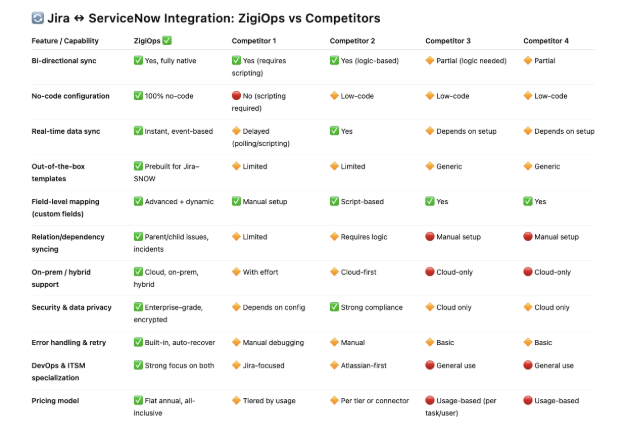
ZigiOps for Your ServiceNow Jira Integration
There are many tools on the market that can integrate ServiceNow with Jira. The question here is how stable are they. What amount of data can they transfer? What are the options for customizations? How about the support? And many other questions.
1. We would like to provide four key points that make ZigiOps stand above all other tools when considering a Jira to ServiceNow integration.
2. No-code integrations. Easy to create, maintain and change your ServiceNow Jira integration.
3. Customizable templates. To cover the most popular ServiceNow Jira integration cases and give you the opportunity to sync whatever you want.
4. Unlimited users and workflows. Sync as many ServiceNow instances as Jira ones and transfer as much data as you need. ZigiOps does not have a limitation on those.
5. Excellent customer support. Whenever you need help with your Jira ServiceNow integration our support team is available to assist and resolve your issues within hours.
Here is what some of our customers share regarding our Jira ServiceNow integration:
“Being a departmental information service center brings strict responsibilities and precise requirements we need to meet. With ZigiOps it is possible to improve the collaboration between our teams and external partners and so be able to resolve incidents and service requests with faster than ever”
Swedish Social Insurance Agency
Initial Setup of the ServiceNow Jira Integration
ZigiOps is a standalone integration platform, which has both an on-premise and cloud version. See the installation process here. The tool does not store any of the transferred data from the ServiceNow Jira integration. It can be either installed on your premises, VM or you can leverage the AWS version of the platform.
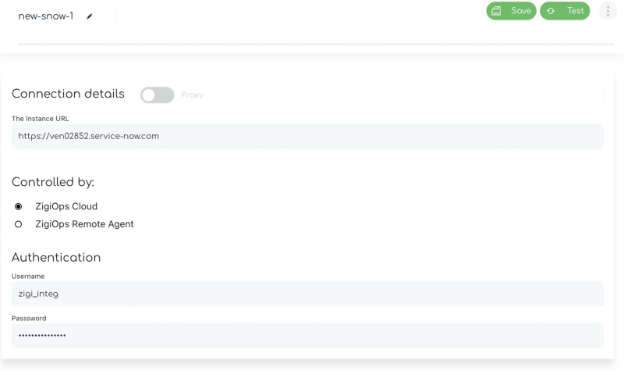
ServiceNow Connection
Once you have installed or connected to ZigiOps, you can log in with your username and password.
Now it is time to choose the systems you want to integrate. ZigiOps uses APIs to connect with ServiceNow and Jira. In our case we first choose the ServiceNow one and fill in three fields:
- ServiceNow system URL
- Username
- Password
The permissions you will need for ServiceNow depend on the integration use case. In this case, we will look at a ServiceNow Jira integration for incidents to tasks.
The permissions you need on the ServiceNow side are:
- incident (READ, WRITE, CREATE)
- sys_db_object (READ)
- sys_dictionary(READ)
- sys_journal_field (READ)
- sys_glide_object (READ)
After filling these, ZigiOps automatically checks the connection with ServiceNow and lets you know its successful. Meanwhile, in the background, the integration platform collects all metadata from ServiceNow and loads all available fields, in order to make the Jira ServiceNow integration easy to create and configure.
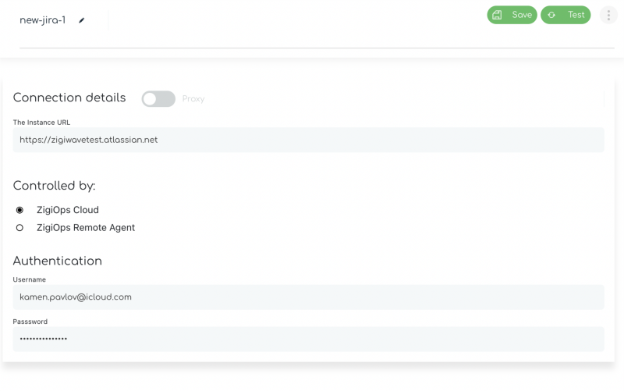
Connecting Jira
Once you have added ServiceNow, its time to add the destination system Jira.
The login process is the same and you will need:
- Instance URL
- User
- Password
Alternatively, you can connect with a proxy. The permissions you need for Jira are:
- Add Comments
- Assign issues
- Browse Projects
- Create Attachments
- Create Issues
- Edit Issues
- Resolve Issues
- Transition issues
If you are using Jira cloud, you also need to fill in the API token.
(Here, you can check Jira's documentation for further instructions and details.)
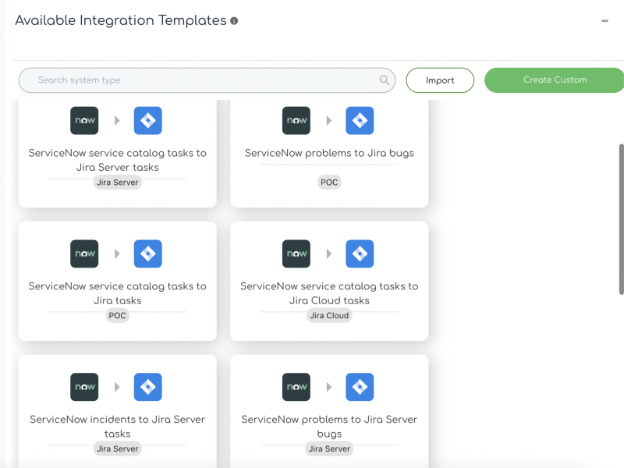
ServiceNow and Jira Integration Templates
After you have successfully connected your instances to ZigiOps, its time to start configuring the ServiceNow Jira integration.
ZigiOps comes with ready-to-use templates with default mappings for the most common integration use cases. All templates are fully customizable and support custom fields and can fit into any use case.
We also have an option for creating an integration from scratch.
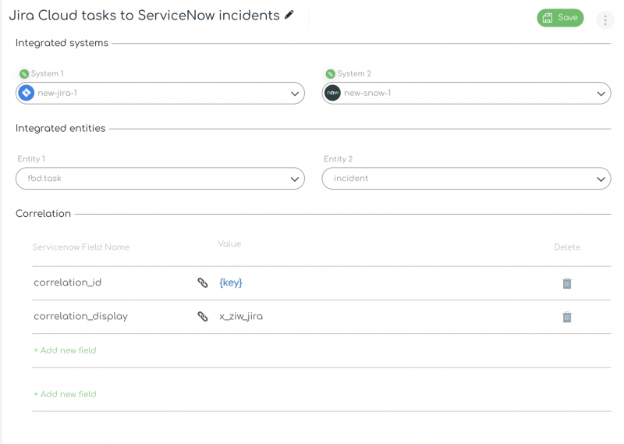
ServiceNow Jira Integration Configuration
Once you load the ServiceNow Jira integration template for incidents to tasks you need to define a couple of things from the drop-down menus:
- Place ServiceNow as a source system
- Put Jira as a destination system
- Choose the entity type from ServiceNow in this case, incident
- Select the entity type from Jira task
After that, you can define the triggers in the correlation section. This means that whenever there is new ticket creation, based on a number of rules, ZigiOps will pull it and load all the information in ServiceNow. ZigiOps supports a variety of things including:
- Reporter
- Priority
- Comments
- Attachments
- Description
- Issue Links and more
Once we are done with this, we can click Save and go to the advanced data mapping of the ServiceNow Jira integration.
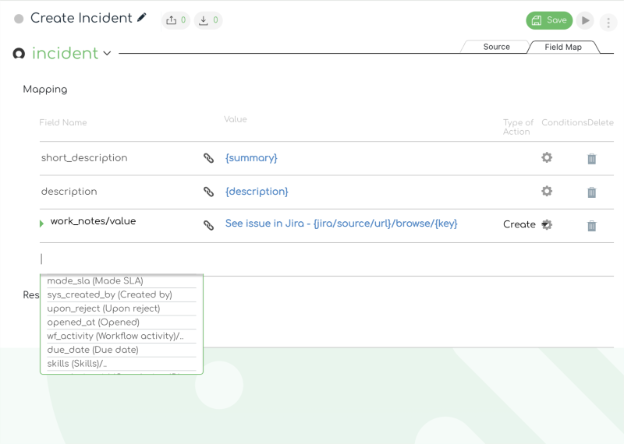
ServiceNow Jira Integration Mapping
Once we enter into the data mapping section we can define the type of trigger we would like to use. For this integration, we will be using polling which means ZigiOps will check for new incidents in ServiceNow on a predefined interval. You can set the interval for minutes, hours, or seconds.
After that, we can define the trigger conditions, meaning when this happens in ServiceNow with these corresponding field names transfer them to Jira.
In the mapping options, we can define which fields get synchronized. In this case, we have:
- summary
- description
- priority
- attachments
- any fields you have in your Jira or ServiceNow
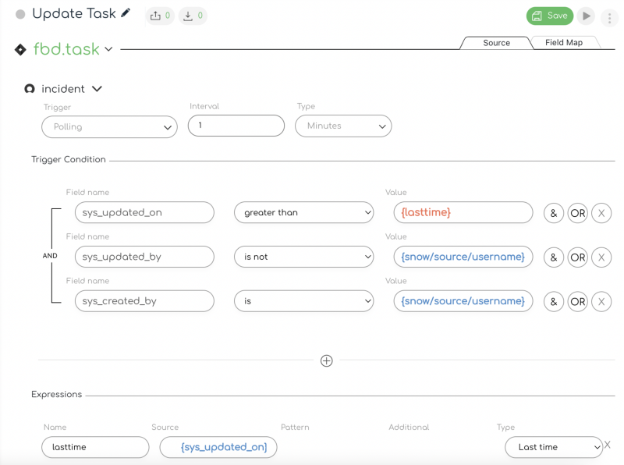
Update Jira Task
The next step of the ServiceNow integration with Jira is to define when should ZigiOps check for updates in ServiceNow and transfer them to Jira.
You can again define the polling interval for hours, minutes, or seconds.
ZigiOps will check ServiceNow for changes every 60 seconds, transform the updates from the incidents, and transfer them to Jira, based on the mappings we have defined.
ZigiOps will find the corresponding mapping field in Jira and update it with an attachment, comment, or anything we have defined.
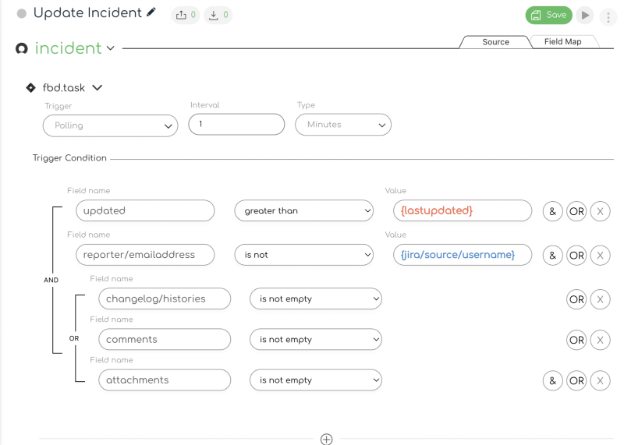
Update ServiceNow Incident
After that, we can define the updates on the ServiceNow incidents, based on the actions your DevOps team has taken and placed in the Jira task.
ZigiOps will poll Jira for changes on the task/s every 60 seconds, or per the interval you select.
The integration platform will transform the Jira task updates to the ServiceNow incidents, based on the mapping
ZigiOps will find the corresponding ServiceNow incident and update or close it, if the DevOps team have finalized it.
Once we are done with that we can save the and enable the integration.
ZigiOps vs Internal Integrations
Choosing the most suitable integration tool for your ServiceNow Jira integration can sometimes create a fuss in the organization. A common misconception is that internal Jira ServiceNow integration development is faster, cheaper, and more effective. Unfortunately, this is not the case. Many customers choose to develop their own ServiceNow Jira integration internally, but after a while realize that this initiative is more expensive, requires a lot of time to configure and test, and in the end, does not fulfill all the requirements. For more information on the difference between internal integration development vs an out-of-the-box product, check our article on the topic.
The most important things you should be looking at when comparing ready integration platforms for the ServiceNow Jira integration versus internal development are:
Meeting all use case requirements, ZigiOps supports 99% of use cases for all of its integrations. With internal development, you will need a Business Analyst to define what you need and only then proceed to development.
1. Budget and timelines: You can launch your integration in a few minutes with a fixed price, instead of spending months on paying salaries to make the integration happen.
2. Maintaining the integration: We have a dedicated support team, who are taking care of the upgrades and have the know-how of Jira and ServiceNow and all other systems we connect. They are available and resolve issues within hours. With internal development, you will need a dedicated engineer to take care of the integration, which will cost you more.
It is not a surprise that meeting all use case requirements is taking the lead. Companies face different scenarios and have specific goals, which are not met by all integration tools on the market.
As mentioned above, we are using the ZigiOps integration platform for this ServiceNow Jira integration guide, as it meets the above-mentioned requirements with:
Simple to configure, yet highly customizable integrations: ZigiOps has predefined integration templates, which you can use to integrate ServiceNow with Jira in a few clicks. It goes beyond that and lets you customize which fields get transferred and updated from one system to another.
This meets nearly all use case requirements for a stable ServiceNow Jira integration as the tool can adapt to almost any use case scenario and complexity level. If your business needs something very niche and specific, which is not currently offered as a customization by ZigiOps, our integration team can develop it within a few weeks.
Automatic upgrades: As ZigiOps is a vendor-certified product, you don't need to make any modifications to your integration in case you upgrade to a newer version of ServiceNow or Jira.
Customer Support: The ZigiOps support team is available to answer any questions and respond to your queries instantly.
Scalable integrations: Ideally, your business will grow over the years. Don't worry about your integrations, though: with ZigiOps, they grow at the same pace. The product has a lot of other features, which you can find here.
Final Thoughts on the ServiceNow to Jira Integration
Team collaboration and work effectiveness are two of the main pieces of your operational efficiency puzzle. Nowadays, when everyone on the market is going all-in, a crucial part of success is developing new product features fast and keeping customers and employees happy. A ServiceNow Jira integration can enable this and help you automate daily tasks and handle issues much faster.
Choosing the right integration tool will not only heavily offload your employees from burdensome tasks, but also speed up the entire new features development flow with smart automation.
Choose simplicity and give ZigiOps a try. Schedule a demo now and start your free trial!
ZigiOps is a secure integration platform, which is certified for ISO 27001. We follow all industry best practices to protect our customers information. ZigiOps does not have a database and cannot store any of the transferred data.
Resources:
*System Integration Market Size, Share, & Trends Analysis Report
Recommended Articles:
- Jira ServiceNow Integration
- ServiceNow Integration Use Cases
- ServiceNow Jira Integration Challenges

